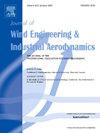Hood-nose and windshield geometry effects on the aerodynamic drag of agricultural tractor trailer couple
IF 4.9
2区 工程技术
Q1 ENGINEERING, CIVIL
Journal of Wind Engineering and Industrial Aerodynamics
Pub Date : 2025-09-01
DOI:10.1016/j.jweia.2025.106220
引用次数: 0
Abstract
Three different agricultural tractor geometries that incorporate a driver cabin/compartment are investigated regarding aerodynamic drag while a trailer is attached. The tractor trailer couple was modelled and scaled down in an open wind tunnel. The main geometrical variables are nose (in front of the hood) form and the windshield angle. The main operational variable is the Reynolds number. Aerodynamic drag force, drag coefficient, and static pressure distribution on the symmetry plane of the tractor trailer couple parameters are found. Reynolds independency was sought to extrapolate results to real world scale. Aerodynamic resistance or drag force was measured in a single axis as well as static pressure from 29 different points. It is found that agricultural tractor trailer couple has an aerodynamic drag coefficient about unity. So, dynamic pressure of the relative flow can be directly multiplied with projected area of the tractor trailer couple that is perpendicular to the relative motion. However, the results also suggests that the drag coefficient can be up to 20 % high based on geometrical variables. Although the drag coefficient does not change marginally, tractor form influences the drag force regarding precise estimations. Obtained findings can be used for complex models or digital twins of transportation.
农用拖拉机挂车对引擎盖-机头和挡风玻璃几何形状的气动阻力影响
本文研究了三种不同的农用拖拉机几何形状,包括驾驶室/隔间,在连接拖车时对空气动力学阻力的影响。这对拖拉机拖车夫妇在一个开放的风洞中建模并按比例缩小。主要的几何变量是鼻子(在引擎盖前)形式和挡风玻璃的角度。主要的操作变量是雷诺数。得到了气动阻力、阻力系数和静压在对称平面上的分布参数。雷诺兹独立性是为了将结果外推到现实世界的规模。空气动力阻力或阻力测量在一个单一的轴和静压从29个不同的点。研究发现,农用拖拉机挂车对具有近似于1的气动阻力系数。因此,相对流动的动压力可以直接乘以垂直于相对运动的牵引车挂车对的投影面积。然而,结果也表明,基于几何变量,阻力系数可能高达20%。虽然阻力系数变化不大,但牵引车的形状对阻力的精确估计有影响。所得结果可用于复杂模型或交通运输的数字孪生。
本文章由计算机程序翻译,如有差异,请以英文原文为准。
求助全文
约1分钟内获得全文
求助全文
来源期刊
CiteScore
8.90
自引率
22.90%
发文量
306
审稿时长
4.4 months
期刊介绍:
The objective of the journal is to provide a means for the publication and interchange of information, on an international basis, on all those aspects of wind engineering that are included in the activities of the International Association for Wind Engineering http://www.iawe.org/. These are: social and economic impact of wind effects; wind characteristics and structure, local wind environments, wind loads and structural response, diffusion, pollutant dispersion and matter transport, wind effects on building heat loss and ventilation, wind effects on transport systems, aerodynamic aspects of wind energy generation, and codification of wind effects.
Papers on these subjects describing full-scale measurements, wind-tunnel simulation studies, computational or theoretical methods are published, as well as papers dealing with the development of techniques and apparatus for wind engineering experiments.

 求助内容:
求助内容: 应助结果提醒方式:
应助结果提醒方式:


